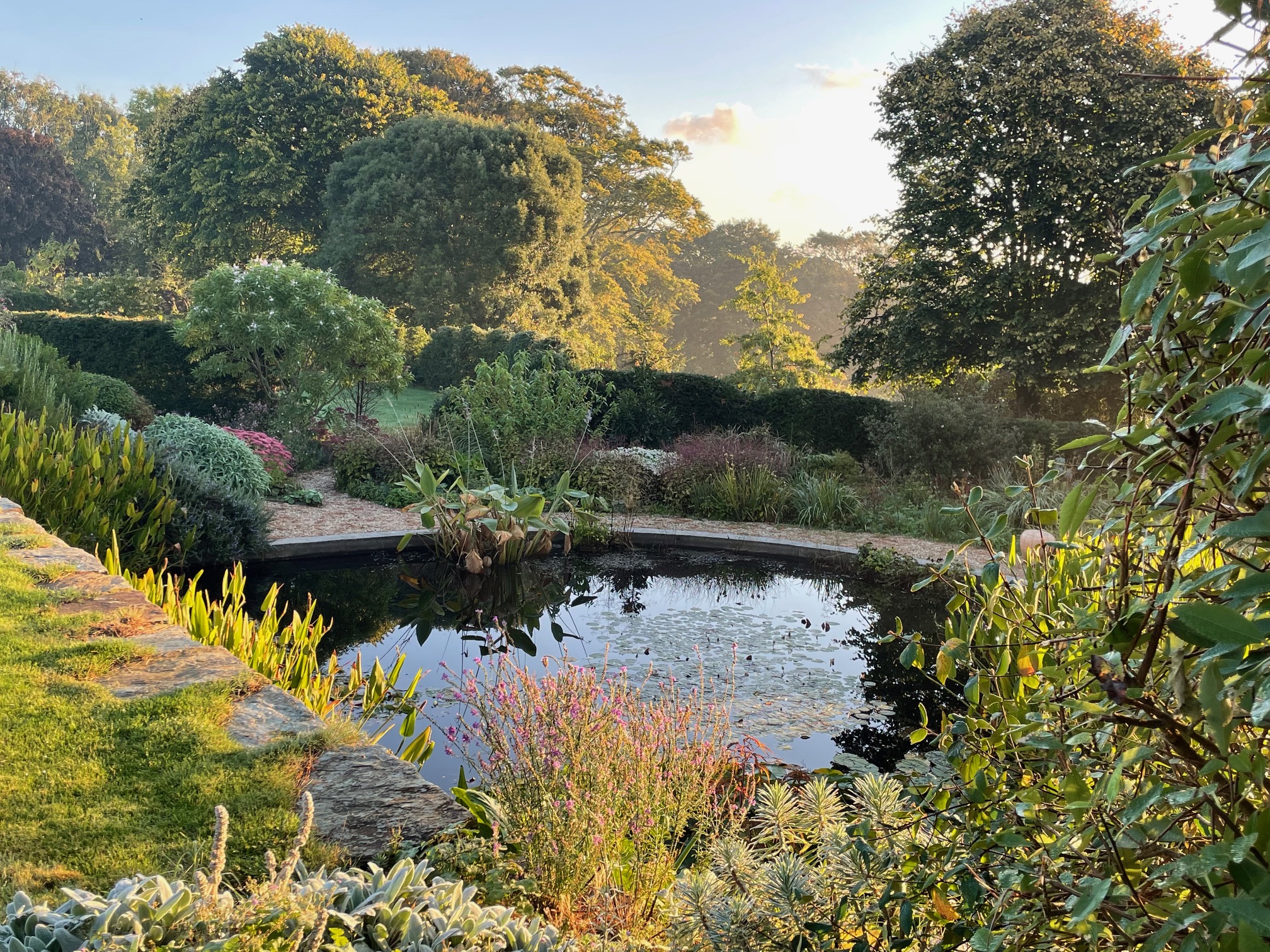
Alison Agnew is the new contributor of the Roseland Online Gardening Feature. She is a retired Biology lecturer and amateur but long time gardener and designer. She has a particular interest in the technical, aesthetic and health aspects of gardening. This is one view of Alison’s garden
Great Expectations
February is the glummest month but now it’s over. Signs of spring bring new hopes for the gardening year and new resolutions.
This year I vow to get my kitchen garden going earlier and more efficiently. The poly tunnel will be a cornucopia of aubergines, tomatoes, peppers and the scent of basil will be overwhelming. The beds will have luscious rows of peas and beans, salads, courgettes and beetroots – and we’ll eat them all before they bolt/die/rot.
This year we will restore the fruit cage and rebuild the compost bins that have collapsed after 15 years. We will have well rotted compost and berries coming out of our ears.
This year I’ll revamp the bits of the borders that need a good sort out. We will mulch and feed and have gluts of glorious flowers from March to December.
This year I’ll remember to cut back the front edge of stands of perennials in May so that they don’t flop. I’ll remember to protect the dahlias from slugs. I’ll control the thugs, nurture the feeble and ruthlessly remove my mistakes.
This year I’ll keep on top of the weeding.
This year I’ll live life hopefully!
But – at the moment I’m looking reality in the face. The cold spell before Christmas and the subsequent heavy rainfall has done a lot of damage. My garden is only 3/4 mile from the coast but there are quite a few casualties.
I have a gravel bank for succulents and other tender plants that like sharp drainage. I’ve lost Aloe striata, several Aeoniums and all the brilliant flowered Aizoaceae including toughies like Lampranthus Tresco Fire. I’ve lost several subshrubs including the stunning Canary Island foxglove Isoplexis canariensis and its hybrid Digiplexis Illumination Raspberry.
On other well drained banks, I’ve lost the Cassia corymbosa that flowered a clear golden yellow well into November, a beautiful dome of Echium fastuosum that would’ve flowered all over purple candles this June and several orange and yellow types of Osteospermum.
One of the saddest sights was Loropetalum chinensis Daybreak’s Flame— which had a lovely late flush of purple leaves and magenta flowers when the frost hit. It is alive but covered in a sad mess of brown leaves. I could cry!
But – living hopefully – there are also wonderful signs of spring.
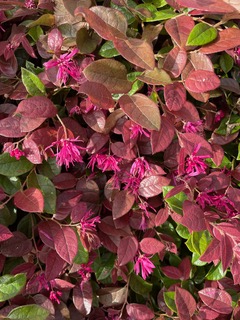
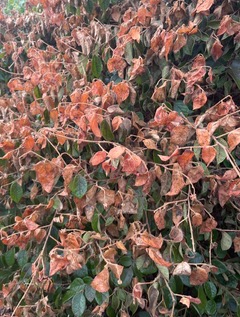
Buds and Bulbs
This is the time of buds – Magnolia buds are especially wonderful, grey and hairy splitting open to the gaudy pink of Magnolia Betty Jessel, rust opening to the purest white of Magnolia crassipes
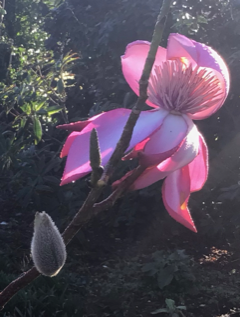
It is also the time for flowering bulbs.
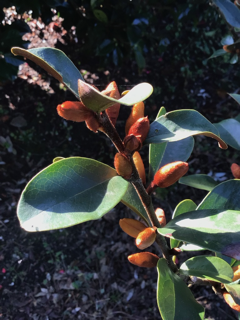
Magnolia crassipes
Snowdrops are such elegant harbingers of spring and they inspire great passion for collecting in some, though, I confess I don’t understand the excitement about tiny variants and just love to see swathes of white nodding single-flowered Galanthus nivalis under trees and shrubs. I have just fallen in love with Galanthus augustus – it has luscious fat leaves and rounded single flowers – so maybe I’m developing a better appreciation.
I prefer single to double-flowered cultivars of most ornamentals but – double flowered daffodils are just an abomination! They lose all the elegance of their frilled trumpets to a clumsy clump of petals – often too heavy to hold their heads up. I love the small types whose leaves are never too dominant in the border as they die back. February Gold and Tete a Tete are delicate but still have impact when planted in numbers – and they are so cheap bought from sites like J Parkers Wholesale that they can be planted by the 100. White flowered Thalia is also a favourite even though it is a larger daff – it looks so beautiful with sharp lime flowered Euphorbias and the wonderful honesty Lunaria annua Corfu Blue. Together, these will light up any dark corner.
Tulipmania is more understandable to me than Galanthomania. They come in so many shapes, sizes and colours. In my last garden, I used to plant them around the feet of shrubs that are cut back hard in winter like Buddleia and Lavatera so their leaves died back as the shrubs grew in summer. Sadly, my soil here doesn’t love them – its too wet in winter. I’m having more success with several small species tulips on my gravel banks – bright red Tulip orphanidea Lizzy, delicate pink/cream multi headed Tulip cretica Hilde and white with a blue centre Tulipa coerulea oculata Alba. They do well in pots and troughs too in a sunny spot. Several specialist tulips are available from Farmer Gracy at not a bad price for such jewels.
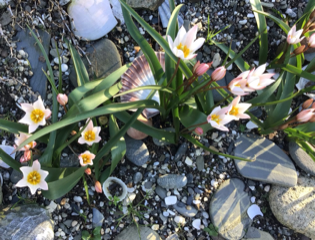
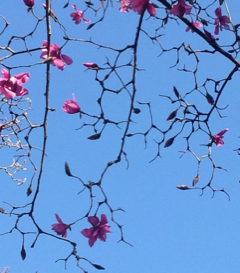
A reminder that March is a great time to visit many of the Cornish woodland gardens – for me, Caerhays takes the prize for its enormous Magnolias seen here 30m above us as a delicate tracery against the sky.
Wonderful evergreen Magnolia doltsopa can be found by following your nose – their scent is hard to describe – lemony perhaps? The other great scented trees there are Nothofagus antarctica – one of the southern hemisphere beeches. The tiny green flowers send out wafts of mixed spice on a warm day.
This year I have a final vow – to get out of my garden and visit others- many others.
Alison Agnew – March 2023

